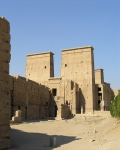Philae Temple
Archaeology »
Archaeological Monuments » Philae Temple
Philae Temple - Egypt
Philae Temple is located in Aswan.
Philae Temple monument was established on 1960.
Primary threats to Philae Temple :
The temples have now been completely dismantled and rebuilt to the original orientation on the nearby island of Agilika which rises higher from the water and has been reshaped and landscaped to resemble the original Philae.
Historical facts of Philae Temple :
- The Philae Temple, also known as the Temple of Isis, is a remarkable ancient Egyptian temple complex located on the island of Philae in southern Egypt. This historically significant site offers insights into the rich history, architecture, and religious practices of ancient Egypt. Let's explore some historical facts about the Philae Temple:
- Significance and Dedication :
The Philae Temple was dedicated to the goddess Isis, who was highly revered in ancient Egyptian religion. Isis was considered the wife of Osiris and the mother of Horus, and her worship extended beyond Egypt's borders.
- Relocation :
Due to the construction of the Aswan High Dam and the subsequent formation of Lake Nasser, the original location of the Philae Temple became submerged. In a remarkable rescue operation during the 1960s, the temple complex was dismantled, moved to a nearby island called Agilkia, and reassembled to preserve this valuable piece of history.
- Architectural Styles :
The Philae Temple showcases a blend of architectural styles influenced by the various dynasties that ruled ancient Egypt. The complex's structures date from the Ptolemaic and Roman periods, displaying elements of classical Egyptian architecture with Greek and Roman influences.
- Temple Layout :
The temple complex is composed of several structures, including the main Temple of Isis, the Kiosk of Trajan, the Gate of Hadrian, and the Temple of Hathor. Each structure served different religious and ceremonial purposes within the overall complex.
- Hypostyle Hall :
The Temple of Isis features a magnificent hypostyle hall, characterized by a series of stone pillars with intricate carvings and hieroglyphic inscriptions. This hall was used for religious ceremonies and rituals, and it demonstrates the grandeur and artistic mastery of ancient Egyptian architecture.
- Festival of Isis :
The Philae Temple was an important pilgrimage site for followers of the cult of Isis. The annual Festival of Isis, known as the "Procession of the Sacred Barque," drew devotees from across Egypt who gathered to celebrate and honor the goddess.
- Hieroglyphic Inscriptions :
The walls of the Philae Temple are adorned with intricate hieroglyphic inscriptions that depict mythological scenes, religious rituals, and historical events. These inscriptions provide valuable insights into the religious beliefs, royal decrees, and cultural practices of ancient Egypt.
- Christian Influence :
During the Byzantine era, the Philae Temple complex underwent a transformation when it became a Christian pilgrimage site. Christian chapels and crosses were added to the existing structures, signifying the coexistence of ancient Egyptian and Christian beliefs.
- UNESCO World Heritage Site :
In recognition of its cultural and historical significance, the Philae Temple complex, along with other Nubian monuments, was designated as a UNESCO World Heritage Site in 1979. This status highlights the global importance of preserving and safeguarding this ancient marvel.
- Tourist Attraction :
Today, the Philae Temple continues to attract tourists from around the world who are fascinated by ancient Egyptian history and architecture. Visitors can explore the temple complex, marvel at its ornate carvings and columns, and immerse themselves in the mystical ambiance that surrounds the island of Philae.
- The Philae Temple stands as a testament to the enduring legacy of ancient Egypt. Its architectural splendor, religious significance, and historical value make it a captivating destination for those seeking to delve into the mysteries of the past.

